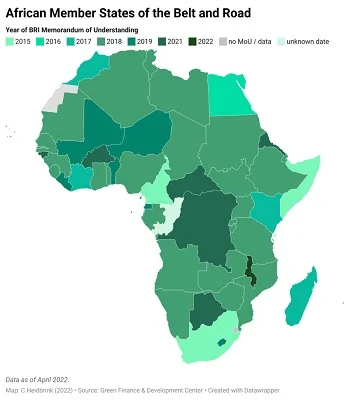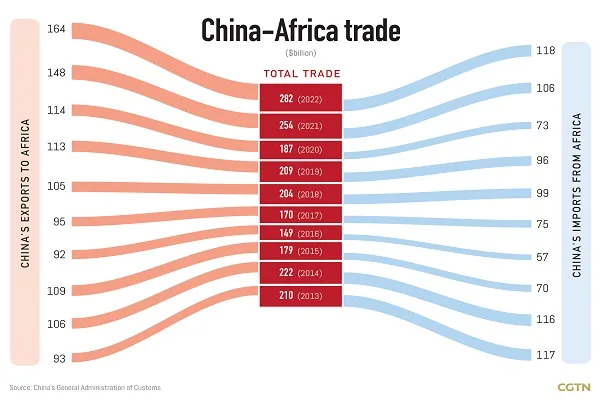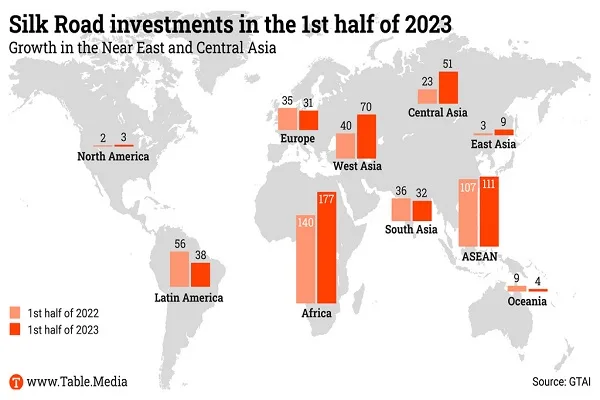Ten Years of BRI In Africa
As at October 2023, 52 out of the 55 countries of the African Union have signed the Belt and Road Initiative for International Cooperation MOU with China, with the notable exceptions of Eswatini, Mauritius and Western Sahara. Eswatini still maintains diplomatic relations with Taiwan; Western Sahara is not yet recognized by China, while Mauritius has allegedly opted out due to pressure from India.
Among the African leaders present at the 3rd Belt and Road Forum (BRF) in Beijing, we note Ethiopian PM Abiy Ahmed, Kenyan President William Ruto and Congo-Brazzaville President Denis N’Guesso. Nigerian VP Kashim Shettina, Egyptian PM Mostafa Madbouly, and Mozambican PM Ariano Maleiane were also in attendance. PM Abiy Ahmed had the distinct honor to deliver a speech during the opening ceremony of the 3rd BRF on 18 October 2023.

China likes to recall the voyage of Zheng He as the historical basis for the Maritime Silk Road (#MSR). Ironically, certain historians point out that the objectives of Zheng He’s voyages (1405-1433) was to buttress the power of the Ming Emperor Yongle (1402-1424) who usurped power through a rebellion. Thus, after the reign of Yongle, the raison d’être for these grandiose overseas missions was no longer present and they were thus terminated.
China is the top trading partner of most of the African countries with total trade volume reaching USD 282 billion in 2022, representing a 14.8% rise compared to 2021. However, the AU is still way behind ASEAN and EU which each boasts near trillion-dollar trade with China.

Evolution of China-Africa Trade (Source: CGTN)
Among the flagship projects under the #BRI, we may mention the Mombasa-Nairobi Standard Gauge Railway (SGR), the Eastern Industrial Zone in Ethiopia and the seaport and military base in Djibouti. China is the largest importer of Angolan crude oil with more than half of the exports destined for the Middle Kingdon. China is also the main investor in #lithium mining in Zimbabwe.
According to Germany Trade & Invest (GTAI), Africa remains still one of main beneficiaries of Chinese largesse with 140 projects financed under #BRI in 2022. For the first semester of 2023, the number of projects financed in Africa has already reached 177. However, in monetary terms, these projects amounted to USD 3.4 billion in 2022, compared to USD 3.7 billion in 2021, thus representing a decrease in value.

A few months before the 3rd BRF (#BRF2023), President Xi proposed three new directions for the BRI in Africa: Industrialization, Agricultural Modernization and Talent Development.
During a recent visit to Beijing, Zambian President Hakainde Hichilema proposed the upgrade of the Tanzania-Zambia Rail (TAZARA), which is a symbol of Sino-Africa friendship during the colonial era. Eventually, the TAZARA could be extended via DR Congo and Angola to form a key economic corridor which links up the Indian Ocean with the Atlantic Ocean and could serve key mining regions rich in #CriticalMinerals.
Africa represents a bank vote in support of China at multilateral fora such as the UN. It is worth recalling that in 1971, it was largely thanks to the African bloc vote behind UN Resolution 2758 that China was finally recognized as the ‘only legitimate China’, in lieu of Taiwan.
The projects undertaken by China in Africa faced criticisms for being white elephants, non-viable or debt traps. The default on foreign debt by Zambia seemed to be consistent with this thesis. In the face of closer scrutiny, China has thus had to recalibrate the #BRI towards ‘high-quality projects.’

